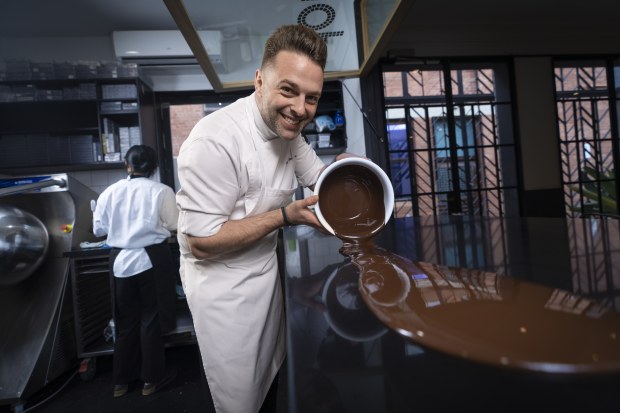For chocoholics, high prices are becoming a not-so-sweet reality. Cocoa supplies are at a four-decade low, Bloomberg reports, which is boosting the costs of big-name candy bars and boutique confections alike. But it’s doing little to quash buyers’ appetites: U.S. chocolate purchases are expected to jump 5.8% this year, according to industry data. Higher prices are driving some of the sales bump, but experts say it’s also because customers are more willing to spend on little luxuries after the pandemic, and they still view chocolate as an affordable indulgence.
- Unfavorable weather is behind much of the cocoa shortage, and El Niño is expected to compound the problem. Growers also cut back on fertilizer use after the war in Ukraine raised prices, further shrinking crops, The Wall Street Journal notes.
By Saundra Latham, Editor at LinkedIn News
Why the price of your favorite chocolate might jump soon
Chocoholics may be in for a shock at the checkout after the price of cocoa soared to a 12-year high and heavy rain across West Africa accelerated the spread of a rot-causing disease.
Cocoa has jumped from $US2356 a metric tonne in July last year to $US3353 on Wednesday, according to Nasdaq. Bloomberg is citing $US3369 a metric tonne cocoa futures on the September contract.

The global price of sugar also hit close to US27¢ a pound in May – the highest since 2011 – after trading for less than US10¢ in April 2020.
Michael Germanos, executive pastry chef at Bibelot, a cafe and artisanal chocolate retailer in Melbourne, says his entire range has been recosted, and most of the $5 chocolate is rising by $2.
But 12 interest rate rises in 14 months have kneecapped discretionary spending for luxury items such as premium chocolate, meaning any price increase is fraught with danger.
A 1 per cent increase in chocolate prices caused the amount of chocolate bought to fall by 7.4 per cent, ABS researchers Robert Ewing, Leigh Merrington and Paul Atyeo found in research released in May.
“Our production costs are skyrocketing,” Mr Germanos told The Australian Financial Review.
“Finding the right balance now is very tricky. Even though we have loyal customers, there is a fine line between having a luxury product and putting it out of reach. There’s a lot of strain on people. Someone who used to buy four or five chocolates here now just buys one.”
Black pod spread
Haigh’s Chocolates chief operating officer Peter Millard said the Adelaide-based company also might have to increase prices.
“It’s [possible] the price of chocolate will rise a little bit – it’s really driven by global forces, and you’re never quite sure where it might end up. Like many things, it’s under price pressure at the moment,” Mr Millard told the ABC.
“We’re not only facing near-record cocoa prices, we’re also seeing cocoa butter, sugar, milk powder all right up the top of their range [the most] that I’ve experienced in my 10 years in the industry.”
Part of the rise in cocoa prices, Mr Millard explained, could be attributed to heavy rain in West Africa accelerating the spread of a rot-causing disease, known as black pod, in some of the world’s big producers.
Farmers in Ivory Coast, Ghana and Nigeria have reported signs of black pod disease, which causes cocoa pods to turn black and rot, Bloomberg has reported.
“It’s one of those threats to the industry that ultimately is affecting price,” Mr Millard said on Thursday.
A spokesman for snack food giant Mondelez, which owns Cadbury and Oreo, said the price of the company’s chocolate products could move.
“The last few years have been extremely challenging for food manufacturers and like many, we have experienced significant supply chain challenges and absorbed rising commodity and input costs,” he told The Australian Financial Review.
“We always hold prices for as long as can. However, we sometimes have to make adjustments to ensure we can continue to manufacture our snacks sustainably and locally in this environment.”
Decision up to retailers
A spokeswoman for Nestlé, which owns Aero, Baci, Kit Kat, Milky Bar and Smarties, said it would hold out on price rises for as long as possible.
“While we’re well aware of the increasing price of cocoa, changes to the price at which we sell chocolate are only made after considering all the variables, of which the price of cocoa is just one,” she said.
“We are working hard to keep prices as low as possible in the face of the inflationary pressures facing our sector. Ultimately, the price at which retailers sell our products to consumers at the shelf is at their discretion.”
Rabobank senior analyst Michael Harvey said while dairy had come down to normal trading levels after hitting record highs 12 months ago, the benefit of such decreases would take time to filter through to manufacturers.
“Some of those commodities markets are elevated, particularly sugar and cocoa. The underlying fundamentals are putting upward pressure on prices,” he said.
Food and non-alcoholic beverage prices in Australia rose 7.9 per cent in May, according to ABS figures. Bread and cereal products were up 12.8 per cent, dairy was up 15.1 per cent, and snacks and confectionary were up 11.5 per cent, outpacing the 5.6 per cent growth in headline CPI.
BY Gus McCubbing, FINANCIAL REVIEW










